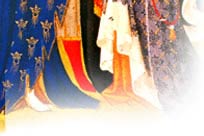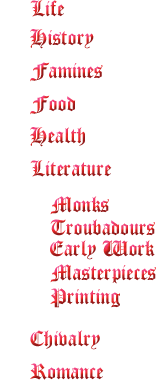 |
|||
 

|
Troubadours Troubadour is the generic term for poets and minstrels who flourished in southern France and in Northern Italy from the 11th through the 13th centuries. Called trouveres in northern France and meistersingers in Germany, these artists elevated storytelling as an art, and often entertained huge crowds at fairs, weddings and other medieval celebrations. During this time, works from medieval monks had become tired. The public wasn't as interested in hymns, chronicles and treatises penned in medieval Latin. These new stories were sang, while music was played on strange, new musical instruments, brought back to Western Europe from the Crusades. Verses became quite complex in style and ranged in topics from satire, love, and politics, to debates, laments and spinning songs. French lords wanted to hear tales of bravery about their own countrymen, and ladies were being swept away with epic love poems, as they practiced the rituals of Courtly Love. Professional singers who performed work penned by a troubadour were called jongleurs, and they might be accompanied by ioculators (jesters) and ystriones (actors). Minstrels were found in every social class, with wealthy or noble troubadours traveling like royalty from town to town. |
 |
|
 |
|||
 |
|||